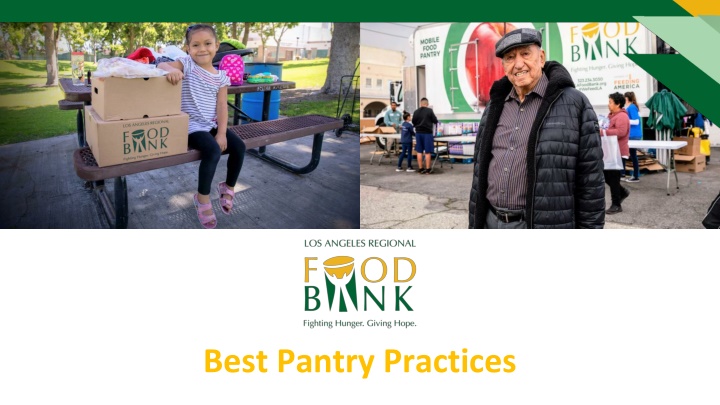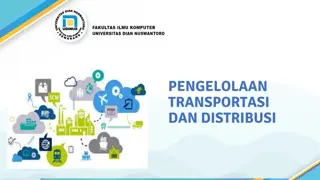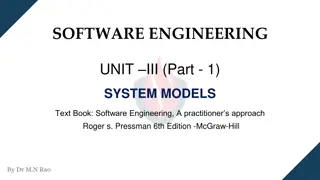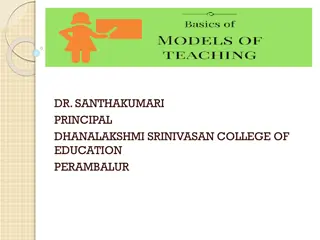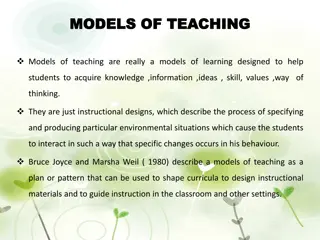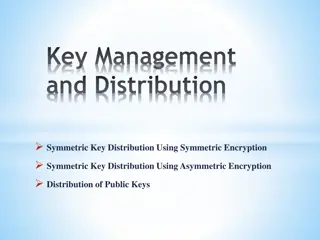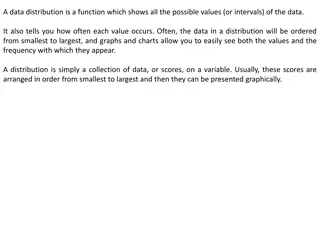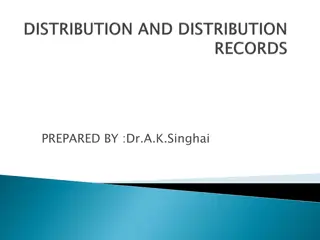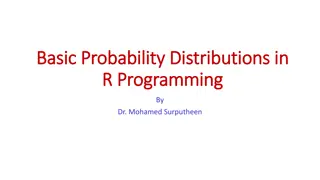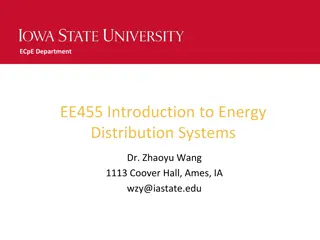Effective Pantry Distribution Models
Implementing best practices in pantry distribution models can enhance client experience, reduce food waste, and promote sustainability. Strategies like client choice, table model, inventory list model, and supermarket model offer personalized, efficient, and empowering ways to distribute food items while fostering dignity and respect. These models encourage active client involvement, promote diverse food selections, and streamline the distribution process for better inventory management.
Uploaded on Feb 24, 2025 | 1 Views
Download Presentation

Please find below an Image/Link to download the presentation.
The content on the website is provided AS IS for your information and personal use only. It may not be sold, licensed, or shared on other websites without obtaining consent from the author.If you encounter any issues during the download, it is possible that the publisher has removed the file from their server.
You are allowed to download the files provided on this website for personal or commercial use, subject to the condition that they are used lawfully. All files are the property of their respective owners.
The content on the website is provided AS IS for your information and personal use only. It may not be sold, licensed, or shared on other websites without obtaining consent from the author.
E N D
Presentation Transcript
Agenda Distribution Models Food Safety Sustainability Volunteer Support Distribution Site Data Gathering/Reporting Communication and Behaviour at Food Pantries
Distribution Model - Client Choice Client Choice: Personalized Experience: Client Choice models empower individuals to select items based on their preference and dietary needs, fostering a sense of autonomy Dignity and Respect: Clients can choose foods aligned with cultural practices, reducing stigma and promoting dignity by allowing them to make decisions for their families Reduced Waste: Customized selections minimize food waste as clients receive items they will use, optimizing resources and benefiting the environment Engagement: Active involvement in the selection process encourages dialogue, building relationships between clients and volunteers
Distribution Model - Table Model Table Model: Guided Selection: Clients are guided through a line of tables, each featuring specific food categories, where they choose items to fill their basket Structured Variety: Ensures a balanced selection of food items by organizing tables with different categories such as fruits, vegetables, proteins, and grains Efficient and Personalized: Combines structured organization with personalized choice, enabling clients to select items with their preference while maintaining an efficient distribution process
Distribution Model- Inventory List Model Inventory List Model: List-Based Selection: Clients choose items from a provided inventory list, indicating the quantities they need from each category. Prepared Choice: Offers a curated list of available items, ensuring a streamlined process and preventing over-selection Enhanced Planning: Enables clients to plan ahead by indicating their preference, allowing food pantries to manage inventory effectively and reduced waste
Distribution Model: Supermarket Model Supermarket Model: Open Selection: Clients navigate the pantry like a supermarket, choosing items from various categories based on their family s needs and preferences. Diverse Choice: Offers a wide range of fresh produce, proteins, grains, and non-perishables, empowering clients to customize their selections for balanced nutrition. Empowerment: Promotes a sense of agency as clients actively participate in their food selection, fostering dignity and reducing food waste by prioritizing items they will use.
Food Safety Practices By adhering to these principles, food pantries can ensure that the food they distribute is safe and contributes positively to the health of their community. Embracing Comprehensive Food Safety: Food safety at food pantries is paramount to safeguarding the health and wellbeing of recipients. This involves: Proper Handling: Adhering to strict protocols for receiving, sorting, and storing food items to prevent contamination and maintain freshness. Hygiene Practices: Ensuring volunteers maintain rigours personal hygiene standards, including handwashing, wearing gloves, and using sanitary equipment. Storage Guidelines: Storing food in designated areas based on temperature requirements and expiration dates to prevent spoilage and ensure safe consumption. Educational Initiatives: Offering regular training sessions to volunteers on food safety practices, emphasizing proper handling techniques and sanitation practices. Quality Checks: Regularly inspecting donated items for signs of damage, expiration, packaging integrity issues. Continuous Monitoring: Implementing a system of regular checks to maintain food safety practices and promptly address any concern that arise.
Sustainability Maintain Nonprofit Status: Comply with Federal and California regulations to remain an active. Operating Funds: Secure funding for rent, salaries, insurance, equipment, and logistics. Seek community support, grants, partnerships, and fundraising opportunities. Team: Recruit volunteers and/or paid staff. Define roles and provide training. Require volunteers to complete an agreement that outlines your agency policies. Logistics: Obtain vehicles, drivers, and insurance. Budget for fuel and maintenance. Utilize delivery from LARFB, if needed.
Volunteer Support By implementing a strong volunteer structure, your agency can function effectively across various areas, ensuring consistent support and successful community services. Integral Support: Volunteers play a crucial role in food pantries They contribute to Development, Food Sourcing, Logistics, Outreach, and Distribution Strategic Recruitment: Aim to recruit twice the required volunteers Ensure a reliable pool for smooth operations Diverse Roles: Assign volunteers to specific tasks Cross-train them for flexibility Clear Descriptions: Develop written job descriptions Clarify responsibilities for each role.
Volunteer Support Formal Agreements: Implement written volunteer agreements. Establish expectations and commitments. Development Volunteers: Seek funds from local sources Assist with grant writing Food Sourcing Volunteers: Collect food from various donors Manage food drive coordination Outreach Coordinator Volunteers: Recruit, collaborate, engage clients Driver Volunteers: Collect food donations
Volunteer Job Assignments Distribution Volunteers: Supervisors: Oversee operations Greeters: Welcome and guide clients on site procedures In-take: Manage Intake. Translators: Assist non-english speakers Stockers: Organize and restock Inventory Control: Manage inventory Shopping Assistants: Help clients choose Carrying Assistants/Runners: Aid with carrying Floaters: Flexible support Paperwork Volunteers Handle certificates (Food Safety, ServSafe, etc.) Manage reports Administer paperwork.
Distribution Site Welcoming Environment: Clean and organized Table Cloths Signage visible in the distribution area Indoor Preference: Distribution locations can be either indoor or outdoors. Indoor settings are preferred for convenience and comfort. Outdoor Setup: If outdoor, consider using canopies for shelter from the elements. Visibility and Direction: Ensure easy discovery of the distribution area. Use signs across to guide visitors to the distribution location. Storage Organization: Maintain clean and organized storage rooms. Open wire shelves are the preferred storage solution, avoiding placing food directly on the floor.
Data Collection and Reporting Data Storytelling: Gather statistics that highlight your agency s impact on the community and the clients that you serve. Show how your program is making a difference Meeting Requirements: Collect necessary data requested by food donors, food banks, and other stakeholders Timely Reporting: Submit reports promptly as required by deadlines Accurate Records: Maintain precise and updated records for transparent reporting
Data Collection and Reporting Sign-in-Sheets: Implement a streamlined sign-in process to collect data crucial data, including demographics and preference, while respecting client privacy and dignity. Neighbor Surveys: Informal - Comment box or through conversations Short interviews or surveys IMPORTANT: Help neighbors understand what and how this information is used
Communication and Behaviour at Food Pantries By promoting respectful behavior and meaningful dialogue, food pantries can create a space where every community member feels respected, heard, and empowered. Cultural Diversity: L.A. county is a vibrant tapestry of culture and languages. Catering to various languages depending where your pantry is located ensures that individuals from diverse backgrounds feel welcomed and understood. Inclusivity: Language access fosters inclusivity by removing communication barriers. Non-English speakers can confidently access services and information, enhancing their sense of belonging. Different languages enables accurate dissemination of important details about food distribution, safety guidelines, and eligibility criteria, leading to more informed participation. Empowerment: Engaging with recipients in a respectful and empowering manner uplifts their dignity. Positive interactions help them feel valued, reinforcing a sense of community.
Communication and Behaviour at Food Pantries (Continued) Communication styles: Adapting communication styles, such as being attentive listeners or employing visual aids, accommodates various languages proficiencies and learning preference, making information accessible Trust Building: Open, empathetic dialogue builds trust, critical for engaging with communities that may have had negative experiences or hesitations regarding assistance programs.
